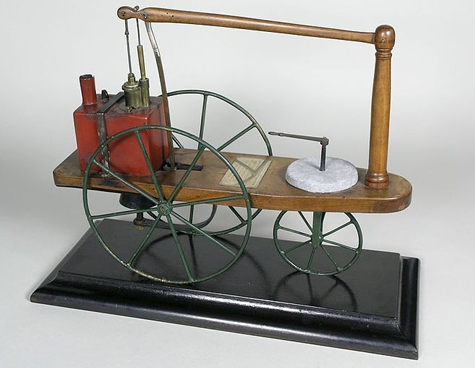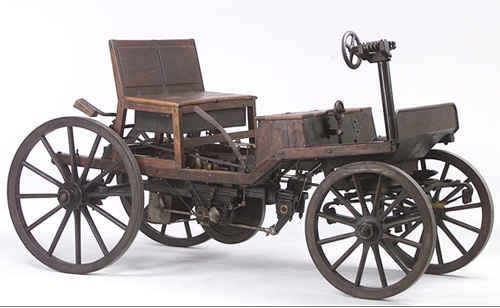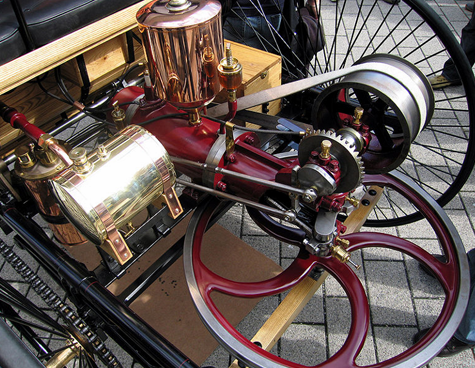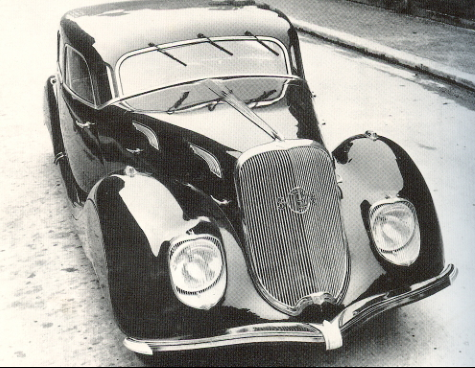We thought that Darwin Day was the perfect time to look at the evolution of the car. So sit down with a cup of coffee and take a trip down memory lane with us.
The first steam-powered vehicle was built in around 1672, invented by Ferdinand Verbiest, a member of a Jesuit mission in China. He made it as a toy for the Chinese Emperor. It was too small to be driven, but it was still a vehicle!
The first automobile patent in the United States was granted to Oliver Evans in 1789, but it was never built.
William Murdoch from Great Britain built a working model of a steam carriage in 1784. And in 1801 Richard Trevithick, also from Great Britain, made a full-sized vehicle, which he ran on roads in Camborne, Cornwall.

As soon as vehicles started being seen on the roads, the technological advancements came in thick and fast. Hand brakes, multi-speed transmissions and better steering were developed.
Some commercially successful vehicles even provided mass transit, until the backlash. This resulted in the United Kingdom Locomotive Act in 1865. This limited speeds to 3km per hour in cities, and 6km per hour in a rural area, and required self-propelled vehicles on public roads to be preceded by a person waving a red flag!
This act slowed down the development of automobiles because it was seen as a big limitation on driving. The law was amended to remove the requirement for a person with a red flag in 1876, but the law wasn’t repealed until 1896.
In 1873 a self-propelled steam road vehicle this could transport groups of passengers was created, in France.
A lack of suitable fuel meant that early attempts at making a combustion engine weren’t great, the fuel that they focused on was gas. In 1806 Francois Isaac de Rivaz, an engineer from Switzerland, built an internal combustion engine powered by hydrogen and oxygen. In 1826, Samuel Brown from Great Britain tested a hydrogen-fuelled combustion engine by using it to propel a vehicle up Shooter’s Hill in London.
Liquid-fuelled internal combustion engines weren’t used until 1870 when German Inventor Siegfried Marcus put a liquid-fuelled internal combustion engine on a handcart, which was named the ‘Marcus Car’. He patented a low-voltage ignition system and made many more vehicles. His second car was the four-seat ‘Marcus Car’, made in 1888, and is still on display at the Technical Museum in Vienna.

Unfortunately, at the time of Nazi Germany, a lot of the records of Siegfried Marcus’ inventions were destroyed, so the more well-known vehicle inventor is Karl Benz, who invented internal, liquid-fuelled combustion engines a few years later than Marcus. The Nazi Party favoured Benz because of his heritage, so left his records untouched. Karl Benz’s work leads to the company we now know as Mercedes-Benz.

One of the first four-wheeled petrol-driven automobiles in Britain as built in Birmingham in 1895 by Frederick William Lanchester. He also invented and patented the disc brake and the first electric starter.
The first company s created to build cars exclusively was Panhard et Levassor, formed in France in 1889. This was followed by Peugeot two years later.
It didn’t take long for the automobile industry to get going. By 1903, 30,204 vehicles had been produced.
It was during this time that controls became standardised, and solid roofs and doors became normal. The development of the combustion engine meant that this was the start of the V8 and V12 engines. Cars produced around this time included the Austin 7, Ford Model A, and Cadillac V-16. This era of the automotive industry lasted until the Wall Street Crash in 1929.
The next automotive industry era started during the Great Depression and ended with the end of the Second World War. During this time saloon car bodies and functional boots were introduced. Headlights were starting to be built into the body of the car around this time, too.

After the Second World War, there were some big design changes. Running boards were removed and fenders were incorporated into the body. Engine power and vehicle speeds increased, and cars became more design focused. Cars started to be exported, you could find Volkswagen Beetles in the USA, and the FIAT 500 outside of Italy. Japan was seeing success with the Toyota Corolla and Corona and also with Nissan, exporting the Sunny and the Bluebird.
Jumping forward to 1973, an oil crisis hit and sales of cars went down. This was added to the stricter safety laws and emission controls, rendering some cars now illegal to drive on US roads. As a result, smaller-cars grew in popularity. Cars such as the Citroen DS, Mini, Porsche 911 and Morris Minor sold well.
Modern era advancements are considered to have started in around 1990, and include the front and all-wheel drives, and the emergence of popularity in hatchbacks, SUVs, and saloons. There is also the focus on emissions and fuel efficiency, which has led to the increase in interest in electric cars.
Electric cars were actually first invented in 1828 by Anvos Jedlik from Hungary, who powered a model car with an electric motor! The first people carrying electric car is considered to be the Flocken Elektrowagen, created by Andreas Flocken way back in 1888, and Electric cars were popular in the late 19th, and early 20th, century, before combustion overtook them because of quicker refuel times and the mass production of liquid fuel.
Now we see electric cars as the future, so it’s like the automotive industry has come full circle!





